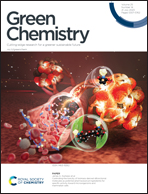The chitin utilization mechanisms of a new Chitinibacter sp. isolate SCUT-21†
Abstract
Chitin is the second largest biomass on Earth; however, chitinous waste is not well recycled by humans. Specifically, physicochemical methods cause pollution and newly developed techniques are expensive. In this case, biorefineries are the most promising method and solid-state fermentation has recently been developed for protein recovery from shrimp shells. Usable chitin-degrading bacteria (CDB) are unavailable and the lack of research on their mechanisms greatly hinders the recycling of chitin. Herein, the newly isolated Chitinibacter sp. SCUT-21 exhibited more robust chitin degradation ability than the presumable major aquatic and terrestrial chitin decomposers Vibrio and Streptomyces. In this study, the genome and transcriptome data showed that 15 of the 20 extracellular chitinolytic enzymes were significantly upregulated by chitin, and 5 recombinant enzymes were identified with their catalytic characteristics. Five transporters, including 2 ChiP, 2 ABC systems, and one PTS system, were significantly upregulated for chitooligosaccharide (COS), (GlcNAc)2, and GlcNAc uptake. With chitin as the sole carbon and nitrogen source, GlcNAc shunted from the EMP and TCA cycle into the bifidum pathway and glyoxylate cycle without CO2 carbon leakage, yielded more ATP, and synthesized poly-β-hydroxybutyrate particles for carbon and energy storage, indicating its adaption for carbon starvation. Proteases and nitrate utilization pathways were significantly upregulated due to nitrogen starvation. The addition of protein could improve the reducing sugar residue in the chitin medium. Expression of the nitrate utilization-associated gene was only induced by (GlcNAc)2. Furthermore, we discuss how the mechanisms of SCUT-21 can be used to develop greener chitin biorefinery methods. We hope that this will prompt more research on the mechanisms of CDB and based on their inherent characteristics, more efficient genetically engineered CDB will be constructed for the recovery of chitin. Combining CDB with proteolytic bacteria, full fermentation methods will enable the future recovery of chitinous waste.



 Please wait while we load your content...
Please wait while we load your content...